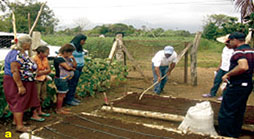Agroecological gardens: a family food alternative
Abstract
The experiences of agroecological family production in different regions of the world have shown that it is a viable option to promote food security, and at the same time, conserve the biodiversity of our countries.
Agroecological movements have played an important role in promoting and sustaining this type of initiative, as a proposal with the potential to address the precarious situation prevailing in the countryside.
Considering these aspects, family farming is the one whose priority use is the family workforce, with limited access to land and capital resources, as well as multiple strategies for survival and income generation. There is a heterogeneous articulation to the markets of products and factors, access and use of different agroecosystems, (Sheider, 2015).
In order to disseminate these agroecological initiatives in the communities, in line with State policies, in the communities of San Isidro, La Secreta and La Tucuzada of the Pedraza municipality of the Barinas state, the community family agriculture program was carried out together with the INIA-PDVSA agreement under the Agroecological Family Gardens project in order to produce healthy food for the family diet, give productive use to unused spaces and generate income for the family.
A participatory diagnosis was carried out that made it possible to detect innumerable needs in the aforementioned communities, among them the following stand out: low socioeconomic level, women with a high percentage of household activities, young people in motorcycle taxi activities and temporary jobs in agricultural production units and tourist companies representing 40% of the inhabitants of the sector, with low weekly income and without counting in the area with job-generating companies.
On the other hand, the largest productive area is represented by the monoculture of yam in a conventional way with high use of agrochemicals that, due to runoff from areas of high slopes and mountains, end up in natural channels such as ravines and the La Acequia river. that it is the source of drinking water for the population of the capital of the Pedraza municipality; as well as, there are many unproductive and wasted spaces destined to the accumulation of garbage and therefore a focus of environmental contamination and generation of family health problems, in the same way, low consumption of vegetables, which lead to child malnutrition.
For this reason, this project was carried out in order to improve the family diet, reduce the use of agrochemicals, take advantage of unproductive spaces and generate income for families.
References
Michelena, V., B. Ngouda y D. González. 2004. Programa especial de seguridad Alimentaria-PESA-FAO, Agricultura Urbana y Periurbana. Manual de micro huertos en Venezuela. Caracas. MPPAT-Venezuela. 67 p.
Rodríguez, A. 2003. Manual de organopónicos y huertos intensivos. Agricultura Urbana. MPPAT-Venezuela, FAO-CIARA. INIFAT_Cuba. 97 p.


